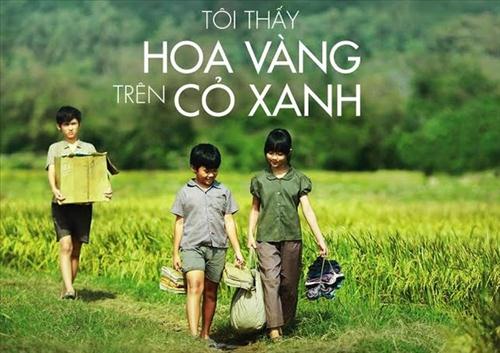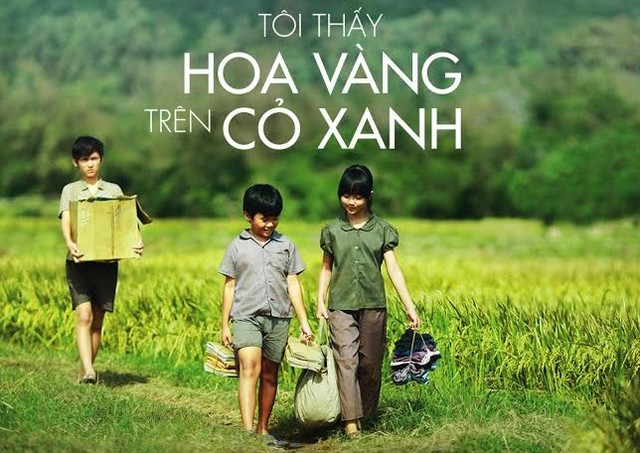
A truly impressive year for Vietnamese cinema
Indeed, last year, 2015, cinema had many impressive events. First of all, right before the New Year, after nearly a century of formation and development (Vietnamese cinema was born around 1923 with the filmKim Van Kieujointly implemented by the French and the Vietnamese), for the first time, a comprehensive and complete "Strategy for the development of Vietnamese cinema to 2020, with a vision to 2030" was officially approved by the state (January 26, 2014). From now on, the country's cinema will have a clearer and more decisive direction, with the expectation that the 7th Art will truly become the "most important of all arts" art form. Not only impressive, with its development strategy, Vietnamese cinema, with many events and activities in the past year, has more or less brought confidence to both professionals and the audience. Anyway, after nearly a century of development, looking at the picture of the country's cinema "growing stunted", the number of films produced annually is surprisingly low (only about a dozen feature films alone); Movies are made but no one watches them, often lose money, are criticized for being poor in content and art, and no one with heart can help but feel "impatient".
For a long time, we often used the excuse that due to lack of money and poor technical conditions, Vietnamese filmmakers could not produce good films that met the tastes of the audience. But since witnessing some neighboring cinemas, such as Iran, whose conditions are not much different from Vietnam's, film budgets are often very low, but they still won major domestic and international awards, even major awards such as Cannes, Venice, Berlina, and even the Oscars. Looking at a closer country, Korea, in the 80s of the last century, cinema in the land of kimchi with a population of less than 50 million (half of Vietnam) was still struggling with domestic audiences, but now, after just over 20 years, Korean cinema has made waves across the continent, even in the US, Japan, and India, the most powerful cinema countries. What factors have brought such great results to the film industry of a country with a population only half that of Vietnam? There are many factors: people, policies, money, and audience level. But the first important factor is a correct policy of the state. So, when for the first time, the country's film industry has a long-term development strategy, the joy for filmmakers and the audience is of course real.
A quick glance at the approved content of the Vietnam cinema development strategy shows that we have every reason to be happy: From now until 2020 (with a vision to 2030), hundreds of new cinemas will be built; Hanoi and Ho Chi Minh City (HCMC) will have more modern cinema centers, producing 25 to 40 feature films each year (by 2030 the number will be up to 60 films, not to mention documentaries, animations, and scientific films with the same number); the state will also invest so that Vietnamese films can compete in foreign competitions; large studios in Hanoi and HCMC will also be invested in and built to meet domestic filmmaking needs, moving towards cooperation with foreign countries; human resource training for filmmaking industries such as directors, film producers, film distributors, actors, etc., will also be focused on investment. Cinema is not only an art, but also an industry in a modern society, without investment in finance and technology it will be difficult to develop. Here is a "half-crying, half-laughing" example told by the director of the cinema, Ngo Phuong Lan, to confirm that. In 2013, the Cinema Department organized the Vietnam Film Week in Korea. After a lot of preparation, we brought to your country more than a dozen of the most typical films in 35mm format, but after the films were selected, transferred and screened in your country, everyone was "shocked" that they could not be shown. The reason is very simple: you have not used projectors for 35mm plastic films for a long time. Almost all cinemas in Korea have now switched to showing digital format films. That “half-laughing, half-crying” situation partly reflects the “lameness” of Vietnamese cinema in the era of integration and modernization, and the simple reason is not because of “lack of money”, but just the lack of the two words “integration”.
The second impression is the film activities throughout 2015, especially the 19th Vietnam Film Festival held in Ho Chi Minh City from December 1 to 5. First of all, we must mention the feature filmFlapping in mid-airby young female director Nguyen Hoang Diep (produced in 2014, but officially released in theaters in early 2015) with many international awards and creating good public opinion with Vietnamese and Southern audiences, especially young people (but almost did not leave much of an impression on the audience in the Film Festival?); short documentaryMs. Phung's last tripby Nguyen Thi Tham, also a very young director, produced before 2013, but officially released in 2015, revealed another surprise: the film was produced by the efforts of only one individual, kept in the "warehouse" for a long time, and when it was released, it suddenly "stole the hearts" of the audience. Then there was the case of the filmFather and son and…by director Phan Dang Di, who was previously famous forBi, don't be afraid, now this young director has caused a stir because his film was selected to compete for the official Golden Bear award at the Berlin Film Festival. However, like the fate of the previous blockbuster film, it has not yet been officially shown in the country (while in France, the screening schedule has been clearly determined). Then the filmsYen's lifedirected by Dinh Tien Vu,14 days leavedirected by Nguyen Viet Khoa, especiallyI am your grandmotherby director Phan Gia Nhat Linh, up to this point the box office revenue has reached a record level: about 90 billion VND (Phan Gia Nhat Linh once cooperated to build a film project sponsored by the Ford Foundation at the University of Social Sciences and Humanities in Hanoi, from here he received a scholarship to study directing at the University of Cinematic Arts of Southern California). It can be affirmed that 2015 is truly a year of young domestic cinema. If we countI see yellow flowers on green grassby Victor Vu (who used to teach at the Cinema Project of the University of Social Sciences and Humanities, Hanoi), also a young director, has contributed significantly to creating an "impression" for a year of cinema, while many other fields of artistic activities in the country are somewhat "stagnant".

In another aspect, cinema has really taken advantage of the huge advantage of television, which has been mentioned in the development strategy of the Cinema Department. In the era of media explosion, especially television, the "big screen" has "lived well" compared to many other art forms thanks to the advantage of taking advantage of broadcasting on the "small screen". Today, cinema and television have become closer and penetrated each other, to the point that people no longer distinguish clearly between television and movies. The "interdisciplinary" nature in the digital age has also increasingly allowed cinema to create a better position. Because once upon a time, cinema was only considered a "pure entertainment", now it has also received the attention of researchers thanks to its "interdisciplinary nature", especially with literature.
Quick statistics of cinema activities in 2015: the beginning of the year is the Award CeremonyGolden Kite, mid-year is a series ofFilm Festival, Film Week, meet with filmmakersEurope, France, Germany, Japan, Korea, India...; then film festivalsYellow Beefor young people organized by the University of Theatre and Cinema, Award CeremonyGolden Lotuswith the activities "We make films", "Film space" of TPD (Center for development of cinema talent, Vietnam Cinema Association); ProgramMeet the fall, a training activity for young cinematographers that has appeared in Da Nang city for several years now, with the participation of overseas Vietnamese director Tran Anh Hung, a number of famous directors abroad and young Vietnamese filmmakers, has also found a new direction in domestic filmmaking. Some young filmmakers who were members of the Hanoi University of Social Sciences and Humanities' Cinema Project sponsored by the Fofd Fund in the period 2005-2011, such as Phan Dang Di, Nguyen My Dung (as co-organizers and lecturers), Trinh Dan Phuong (as screenwriter)..., have initially had very encouraging results (the script of Trinh Dan Phuong, currently a graduate student majoring in cinema at the Hanoi University of Social Sciences and Humanities) has received a prize of 3,000 USD to continue investing in production costs). Another student of the Cinema Project, Pham Thanh Ha, also received an award in the 2015 animation script writing competition (Pham Thanh Ha also received an animation script award in the 19th Film Festival). Finally, the most impressive thing about Vietnamese cinema in 2015 was the unexpected success of the cooperation between the private film studio Thien Ngan and the partial investment of state capital for the film.I see yellow flowers on green grass,The film won the Golden Lotus award at the 11th Vietnam Film Festival in Ho Chi Minh City at the end of the year. It is even said that Phu Yen tourism industry also benefited from the “picturesque” scenes in Victor Vu’s film. Obviously, Vietnamese cinema in 2015 had many impressions…

But is Vietnamese cinema 2015 really “quality”?
If we only look at cinema from the perspective of “fun, youthfulness”, an art of beauty (especially beautiful actors with an overwhelming number of showbiz), high-grossing movies, regular international exchanges, a few beautiful frames, 5-channel surround sound, thrilling stories, fighting scenes, especially the trend of gay movies, 16+ movies…, Vietnamese cinema in recent times, especially in 2015, has “many impressions”, but has it really had “value”?, we cannot confirm that too soon.
Why is that? It's simple: in addition to a number of activities that have been very hard-working and dedicated over the past year by many units, organizations, and individuals: the management and direction of the Department of Cinema; the training activities of the two schools of Theater and Cinema in Hanoi and Ho Chi Minh City, and a number of non-specialized schools; the Vietnam Television and Feature Film Studios, the TPD Center, private film studios and overseas Vietnamese filmmakers), and the artists who are truly professionals, there are still many other film activities that are heavily "following trends". Vietnamese cinema in 2015 still has many phenomena of "hybridization", "imitation", "borrowing", using "tricks", confusing "cinematic acting" with "showbiz performance"..., which is partly just to hide the lack of artistic thinking. Just look at theFestivals, Award ceremonies, exchange activities, film advertisingin the year, then we know right away that Vietnamese cinema in 2015, although there was some "excitement" outside, but there was no uniformity in "quality". Vietnamese cinema in the integration period still has many "inadequacies": not yet past the stage of making art films, it has "learned" to make "market" films; some films achieved high box office revenue, attracting many audiences, for example, even withI am your grandmother, is still not entirely a pure Vietnamese film (the script was purchased from Korea); some other films have artistic quality (according to experts' assessment), but have not necessarily found the "sympathy" of the majority of Vietnamese audiences (Flapping in the air, Father and son and…), or the film was invested with a large amount of capital but failed at the box office (Living with history); or half of the movies are nonsense, labeled 16+ with the purpose of "clearly attracting attention" while most of the movie's content is still poor; just look at the list of 20 feature films competing for awards in the 19th Film Festival and you will know: more than half of them are marked 16+ (movies banned for children under 16 years old, a trick to "attract viewers, nothing more, nothing less!").
Another important content of a national cinema is the issue of human resource training, but even the "Strategy for Cinema Development to 2020, Vision 2030" that the Cinema Department recently announced still appears to be quite "superficial". While human resources are the important factor contributing to creating a truly quality cinema. I think that human resource training here is not only training filmmakers, but also training moviegoers. And if we only look at the surface of the number of young people, "talented actors and beauties" "flocking" to the cinema, we are very happy. But inside that joy, there are actually still many worries. Because, for many of them, going to the cinema is sometimes just "following the trend". While we really need viewers equipped with real cinema knowledge. To achieve that goal, one thing cannot be delayed: we really need to have more than the current 2 specialized training schools (Saigon and Hanoi University of Science and Technology); we need to professionalize (including socialize) the film human resource training models. A country with more than 90 million people like Vietnam, cannot have only two film training facilities. In Korea, a country with less than 50 million people, but there are more than 40 film training facilities. In the US, almost every university has a film training department, some even have two to three departments. In fact, for about ten years now, at a number of Vietnamese universities, especially the large schools, such as the University of Social Sciences and Humanities, the University of Culture, Military Arts, Hoa Sen University, Colleges of Culture and Arts, etc., have also participated in professional training of film human resources. However, the “Vietnam Cinema Development Strategy” until 2030 hardly mentions them. If a film workforce is not diversified in training, it will be very difficult to realize the vision of world integration. Diversification means not only training in filmmaking, but also film criticism and writing about films; not only training directors and actors, but also training producers (while, in fact, even at the two most professional training institutions in the country, there is still no Film Production faculty), and many other issues...

Mr. Tran Hinh
Director Dang Nhat Minh, one of the most serious and contributing people to the country's cinema, has confided more than once: his generation, although making films under the subsidy period, with a small budget, still had films that exuded the "soul" of the Vietnamese people, and received many international awards. And Vietnamese cinema today may have become closer to the international level, more "modern", but is it true that there is still a lack of films with "Vietnamese soul"?
Of course, not only cinema, but also any field, as I understand, in every era there are good and bad things, what has been done and what has not been done. The important thing is that those responsible, the cinema managers, must “think about” and “speak out”; there needs to be “help” and “contribution” from many people. And another important thing is that there needs to be real talents with “Vietnamese Soul”, not an “awkward patchwork”. Only then will the country’s cinema have a chance to “take off”.
Author:Tran Hinh
Newer news
Older news